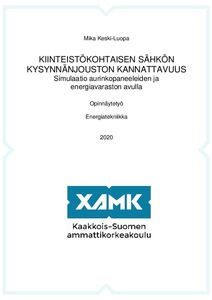Kiinteistökohtaisen sähkön kysynnänjouston kannattavuus: Simulaatio aurinkopaneeleiden ja energiavaraston avulla
Keski-Luopa, Mika (2020)
Keski-Luopa, Mika
2020
Julkaisun pysyvä osoite on
https://urn.fi/URN:NBN:fi:amk-2020052513357
https://urn.fi/URN:NBN:fi:amk-2020052513357
Tiivistelmä
Energia-alalla on käynnissä energiamurros. Ilmastonmuutoksen hillitsemiseksi halutaan fossiilisien polttoaineiden käyttöä vähentää energiatuotannossa ja uusiutuvan energian-tuotantoa lisätä. Lisäksi tarvitaan kuluttajien aktivoitumista uusien ympäristöystävällisten energiaratkaisujen suhteen. Näihin kuuluu mm. kiinteistöissä toteutettu pienimuotoinen uusiutuvan energiantuotanto ja tehopiikkien aikaisen energian käytön hetkellinen vähen-täminen kysynnänjouston avulla. Sähkön kysynnänjoustoa voidaan suorittaa esimerkiksi ohjattavilla kuormilla tai energiavarastojen avulla.
Tämän opinnäytetyön tavoitteena on simuloida kiinteistössä tuotetun aurinkosähkön ja kysynnänjouston kannattavuutta Päiväkoti Onnenkenkä Oy:ssä. Simulaatiot tehtiin Excel-taulukossa vuoden 2019 todellisen tuntikohtaisen sähkönkulutuksen perusteella. Simu-laatioiden tarkoituksena oli selvittää, kuinka suuri osuus valittujen aurinkopaneeleiden sähkön tuotannosta voidaan käyttää kiinteistössä. Simulaatiossa ylijäämäsähkö myytiin yleiseen jakeluverkkoon. Energiavaraston tehtävänä simulaatioissa oli toteuttaa kysyn-nänjoustoa vähentämällä tehohuippujen aikana ostetun sähkön määrää. Koska simulaa-tiossa päivittäinen sähkön kokonaiskulutus ei muutu, sähkö siirtyi ostettavaksi kulutus-huippujen ulkopuolella. Energiavarasto varastoi myös aurinkopaneeleilla tuotettua ylijää-mäsähköä käytettäväksi muina aikoina. Tämän tarkoitus oli nostaa kiinteistössä tuotetun aurinkosähkön omakäyttöosuutta.
Simulaation tuloksena saatiin kannattavuuslaskelma valittujen aurinkopaneeleiden ja energiavaraston investointiin. Kannattavuuslaskelman perusteella saatiin selville se ta-kaisinmaksuaika, jonka sisällä investointi maksaa itsensä säästyneillä energiakuluilla. Erikseen arvioitiin myös energiantukien vaikutusta investoinnin kannattavuuteen. Tässä opinnäytetyössä keskityttiin Päiväkoti Onnenkenkään. Työtä voi käyttää myös välineenä arvioitaessa vastaavia investointeja muiden saman sähkön kulutusprofiilin omaavien kiin-teistöjen osalta. Näitä ovat mm. kaikki sähkölämmitteiset palvelu- ja toimistorakennukset, joissa ei käytetä kesällä jäähdytystä. The energy sector is undergoing major changes. In order to curb climate change, it is desirable to reduce the use of fossil fuels in energy production and increase the production of renewable energy. In addition, there is a need for consumers to direct themselves towards new environmentally friendly energy solutions. These include e.g. small-scale real estate renewable energy production and tem-porary reduction of energy consumption during power spikes with a demand response. The electric-ity demand can be responded to for example with controlled loads or energy stores.
The aim of this thesis was to simulate the profitability of solar electricity generated on the property and the demand response of electricity in Päiväkoti Onnenkenkä Oy, a kindergarten located in Ori-mattila. The simulations were performed in an Excel-sheet based on the actual electricity consump-tion in 2019. The purpose of the simulations was to determine the proportion of the electricity gener-ated by the selected solar panels that could be used on the property. In the simulation, the surplus electricity was sold to the public distribution network. The task of the energy warehouse in the simu-lations was to create flexibility to the demand by reducing the amount of electricity purchased during peak hours. Because in the simulation the total daily electricity consumption did not change, the electricity purchases were shifted outside of peak consumption hours. The energy storage also stores the surplus electricity produced by solar panels to be used at other times. The purpose of this is to increase the share of self-produced of solar electricity in the property.
The simulation resulted in a profitability calculation for the selected solar panels and energy storage investment. Based on the profitability calculation, the payback time was defined within which the investment pays for itself with the saved energy costs. The impact of energy subsidies on the profit-ability of the investment was also assessed separately. The thesis was focused on Päiväkoti On-nenkenkä. However, it can also be used as a reference when assessing similar investments to other real estates with the same electricity consumption profile. These include e.g. all electrically heated service and office buildings where no cooling machinery is used in the summer.
Tämän opinnäytetyön tavoitteena on simuloida kiinteistössä tuotetun aurinkosähkön ja kysynnänjouston kannattavuutta Päiväkoti Onnenkenkä Oy:ssä. Simulaatiot tehtiin Excel-taulukossa vuoden 2019 todellisen tuntikohtaisen sähkönkulutuksen perusteella. Simu-laatioiden tarkoituksena oli selvittää, kuinka suuri osuus valittujen aurinkopaneeleiden sähkön tuotannosta voidaan käyttää kiinteistössä. Simulaatiossa ylijäämäsähkö myytiin yleiseen jakeluverkkoon. Energiavaraston tehtävänä simulaatioissa oli toteuttaa kysyn-nänjoustoa vähentämällä tehohuippujen aikana ostetun sähkön määrää. Koska simulaa-tiossa päivittäinen sähkön kokonaiskulutus ei muutu, sähkö siirtyi ostettavaksi kulutus-huippujen ulkopuolella. Energiavarasto varastoi myös aurinkopaneeleilla tuotettua ylijää-mäsähköä käytettäväksi muina aikoina. Tämän tarkoitus oli nostaa kiinteistössä tuotetun aurinkosähkön omakäyttöosuutta.
Simulaation tuloksena saatiin kannattavuuslaskelma valittujen aurinkopaneeleiden ja energiavaraston investointiin. Kannattavuuslaskelman perusteella saatiin selville se ta-kaisinmaksuaika, jonka sisällä investointi maksaa itsensä säästyneillä energiakuluilla. Erikseen arvioitiin myös energiantukien vaikutusta investoinnin kannattavuuteen. Tässä opinnäytetyössä keskityttiin Päiväkoti Onnenkenkään. Työtä voi käyttää myös välineenä arvioitaessa vastaavia investointeja muiden saman sähkön kulutusprofiilin omaavien kiin-teistöjen osalta. Näitä ovat mm. kaikki sähkölämmitteiset palvelu- ja toimistorakennukset, joissa ei käytetä kesällä jäähdytystä.
The aim of this thesis was to simulate the profitability of solar electricity generated on the property and the demand response of electricity in Päiväkoti Onnenkenkä Oy, a kindergarten located in Ori-mattila. The simulations were performed in an Excel-sheet based on the actual electricity consump-tion in 2019. The purpose of the simulations was to determine the proportion of the electricity gener-ated by the selected solar panels that could be used on the property. In the simulation, the surplus electricity was sold to the public distribution network. The task of the energy warehouse in the simu-lations was to create flexibility to the demand by reducing the amount of electricity purchased during peak hours. Because in the simulation the total daily electricity consumption did not change, the electricity purchases were shifted outside of peak consumption hours. The energy storage also stores the surplus electricity produced by solar panels to be used at other times. The purpose of this is to increase the share of self-produced of solar electricity in the property.
The simulation resulted in a profitability calculation for the selected solar panels and energy storage investment. Based on the profitability calculation, the payback time was defined within which the investment pays for itself with the saved energy costs. The impact of energy subsidies on the profit-ability of the investment was also assessed separately. The thesis was focused on Päiväkoti On-nenkenkä. However, it can also be used as a reference when assessing similar investments to other real estates with the same electricity consumption profile. These include e.g. all electrically heated service and office buildings where no cooling machinery is used in the summer.
